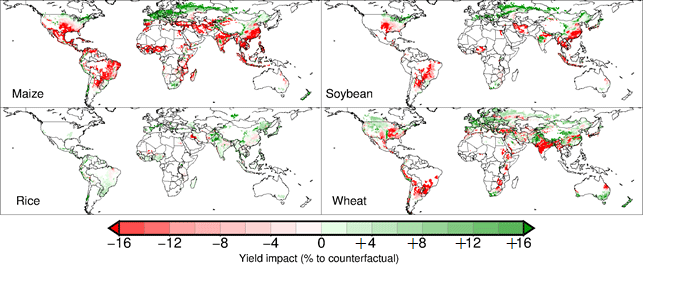News
World's Major Grain Yields Suffer 5 Trillion-Yen Damages per Year - NARO Study Shows How Global Warming Affects Yield of Grain Updated in February 2019
Global warming directly affects yield of agricultural crops we eat. It is scary to know how much damage has already been inflicted. According to a team of researchers from Japan's National Agriculture and Food Research Organization (NARO) led by Toshichika Iizumi, the amount of damage to maize, wheat, and soybeans has almost reached 46 billion USD or 5 trillion yen a year.
It was already estimated that global warming reduced the yield of maize and wheat in the world by several percent in comparison to the state of the world without global warming. However, previous studies have focused primarily on the relationship between individual weather elements, like temperature vs yield or rain vs yield. Such studies did not include the aspect of how climate change could influence plant growth. Therefore, it was necessary to confirm the correctness of the estimation by a completely different method.
Iizumi and his colleagues focused on the mechanism of plant growth. Climate conditions like temperature and rainfall were labeled as “causes.” “Results” or the yield would be calculated by considering how plants would be influenced by the cause. This is a new method of identifying global warming and crop yield in a causal relationship. Other elements like use of fertilizers, breeding varieties, and changes in seeding time were also incorporated in the calculation.
Iizumi and his colleagues started with a huge database called “d4PDF” that enables comparison between present climate with progressed global warming and past climate without global warming. Based on this, the team estimated the yield of grains that would already be damaged by global warming.
Averaging the 30 years between 1981 and 2010, the world's maize yield had declined by 4.1% compared to the state of climate without any global warming. Yield of wheat (spring wheat) fell 1.8% and yield of soybeans fell 4.5%. When converted into producer price from 2005 to 2009, the total loss for maize, wheat and soybeans had reached 42.4 billion USD or a little more than 4 trillion yen per year. Rice was not specifically affected by global warming.
By region, yield of maize, wheat, soybeans, and rice fell in low-latitude areas and increased in high-latitude areas. Even in low-temperature high-latitude lands where these grains are difficult to grow, it is estimated that global warming is facilitating the cultivation of these crops. In low-latitude areas where the temperature during growth-period is already high, the temperature had risen even further to result in decreased yield.
Based on the results of this study, the amount of damage caused by global warming can also be calculated for each country. When considering financial aid to low-latitude countries for instance, this study can be used as fundamental scientific data.








